- 1Center for Space Plasma and Aeronomic Research, The University of Alabama in Huntsville, Huntsville, AL, United States
- 2Department of Space Science, The University of Alabama in Huntsville, Huntsville, AL, United States
- 3Edu Inc., Palo Alto, CA, United States
The field of Space Physics has significant recruitment potential. Almost everyone has been fascinated by space in one way or another since their early childhood. From this perspective, Space Physics might be expected to exhibit considerable diversity as a discipline. Regrettably, as in many STEM fields, the reality is quite different. Numerous reasons have been advanced about why the reality and the expectation diverge but one observation we have made over the years stands out, and, that is, that when students are given the opportunity, they are very eager to learn about Space Physics and enthusiastic about working on space physics projects. At The University of Alabama in Huntsville, we have developed a series of outreach programs, including summer programs, that are aimed at bringing students not typically exposed to space physics into the Space Physics community through working on real research projects that have the potential to produce journal publication results. These programs have been very effective in creating interest in Space Physics and have led to the recruitment of students that have been underrepresented historically into our research programs. In this paper, we summarize the various summer programs that the Center for Space Plasma and Aeronomic Research and Department of Space Science at The University of Alabama in Huntsville have been organizing in Space Physics for years and how these programs have contributed to increasing diversity in the field.
1 Introduction
Diversity, Equity, and Inclusion (DEI) metrics in the Space Physics research community have been documented by the American Geophysical Union (AGU) which is the world’s largest society in geophysics. According to the AGU’s DEI Dashboard1 that is, based on self-reported demographic data of AGU members in 2020, AGU members predominantly consisted of white men. The specific breakdown is 60% male and 28% female, based on self-reporting, with 54% white, 6% Asian American, 4% Hispanic Latino, and ∼1% black; and 50% between the ages of 30 and 59, and ∼18% under the age of 30 years old. These demographics data are based on AGU members from 146 countries with the following distribution: 61% United States, 16% Asia, 15% Europe, 6% Africa and the Americas, and 2% from Oceania. The latter data shows that the majority of AGU members come from the United States, Asia, and Europe. Figure 1 is a graphical representation of AGU diversity and gender breakdown. These pie charts provide a more global perspective of the demographic data that we present below in analyzing the demographic and gender results from our summer programs. If we wish to look at demographic data at a national level, Europe’s biggest, and the world’s third biggest, contributing country to AGU publications in 2020, the United Kingdom, is a good choice. The report entitled “Demographics of the United Kingdom Space Sector”2, published in 2021, presents the first comprehensive demographic statistics for the United Kingdom space sector. United Kingdom women and ethnic minorities are again significantly underrepresented, corresponding to 29% and 11%, respectively, in the space sector population. These two representative datasets illustrate that women and ethnic minorities are significantly underrepresented in the Space Physics national and international communities. A question frequently raised but not typically addressed very concretely is how an individual institution such as a university or a small coalition of university and laboratory partners makes a difference to DEI in, e.g., space physics. As we discuss further below, we take this question and try to build a strategy for addressing DEI at the local level instead.
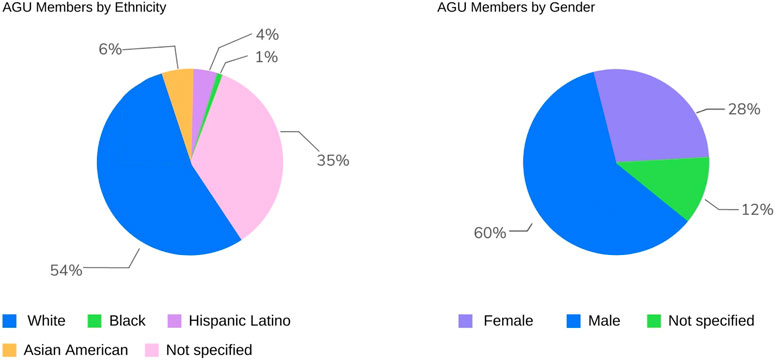
FIGURE 1. Summary of demographic and gender data for the American Geophysical Union (AGU) according to their DEI Dashboard1.
While the question of DEI in a particular discipline, be it space physics or plasma science and engineering (PSE), is self-evidently important when considered nationally or internationally and has attracted considerable discussion, our experience, particularly that of the second author, is that discussion focused largely at a national level does very little to address problems on the ground that a typical department chair faces in trying to actually increase the number of woman faculty or diversify the student body. For example, we have found neither the American Physical Society Bridge Program3 nor the AGU Bridge Program4 particularly useful in improving DEI for the Alabama university consortium discussed in this paper. Accordingly, we have adopted very practical approaches in trying to improve diversity in our local and rather small part of the world, and identified what needs to be done to achieve a desired DEI outcome.
Support for our DEI and outreach efforts derives from two National Science Foundation (NSF) programs, an NSF Research Experiences for Undergraduates (REU) grant and two successive NSF EPSCoR Track-1 grants. The first of the NSF EPSCoR RII Track-1 grants was entitled CPU2AL: Connecting the Plasma Universe to Plasma Technology in AL: The Science and Technology of Low-Temperature Plasma. The NSF EPSCoR Project5 CPU2AL aimed to enhance low temperature plasma research (including important elements of space plasma physics) in Alabama by building a partnership comprising nine universities and a research corporation in Alabama (Alabama A&M University, Alabama State University (ASU), Auburn University, CFDRC, Oakwood University, Tuskegee University, The University of Alabama, The University of Alabama at Birmingham (UAB), UAH, and University of South Alabama). CPU2AL is led by UAH (G.P. Zank is the principal investigator on the grant). A new NSF EPSCoR RII Track-1 grant was awarded in mid-2022 entitled Future Technologies enabled by Plasma Processes (FTPP)6, also led by UAH with the same consortium of AL universities and principal investigator.
To set sensible goals and make meaningful progress, we began with a baseline assessment of the state of DEI in our CPU2AL and FTPP consortium institutions. The baseline assessment included faculty, researchers (including post-docs), and student participation in PSE-related fields. In this paper, we focus on the recruitment of the youngest members of the Space Physics research community, viz., undergraduate and graduate students in STEM fields (additional goals of both CPU2AL and now FTPP were/are, e.g., to increase the diversity of the faculty in our universities, which has proved very successful but this is a separate discussion). One of our major goals with the three NSF programs was to make measurable sustainable improvements in the gender and ethnic diversity of the STEM pipeline and workforce in Alabama, as well as educating the AL general public about PSE. Demographic data from the AL consortium (Alabama A&M University, Alabama State University (ASU), Auburn University, CFDRC, Oakwood University, Tuskegee University, The University of Alabama, The University of Alabama at Birmingham (UAB), UAH, and University of South Alabama) was tabulated in terms of gender, underrepresented minorities (URM), including African American, Hispanic, first-generation, and female, for faculty, researchers, and students alike. The baseline assessment provides an understanding of the immediate local demographics, which enabled us to develop a specific set of five-year quantitative individual diversity goals (URM and female) (first for the CPU2AL and now for the FTPP program). These goals were based on assuming 1) an
Our goals are to have our summer programs 1) increase the female and URM undergraduate student population in AL PSE and space physics, and 2) transition a significant fraction of that undergraduate student population to graduate PSE-related programs to increase both the number and diversity of our AL graduate student population. The diversity goals enumerated above are realistic given the challenge facing PSE as documented in a February 2021 report from the American Institute of Physics (AIP) on Current Trends in Physics PhDs (Mulvey et al., 2021). The two fields central to PSE, plasma physics and materials science, were ranked 10 and 7, respectively, out of 16 identified subfields in terms of the total number of graduating PhDs averaged over 2 years (2017/18). Together, these two fields produced 130 out of 1900 (6.8%) Physics PhD degrees nationwide. When combined with the low representation in the Physics profession of women (
The Center for Space Plasma and Aeronomic Research and Department of Space Science (CSPAR/SPA) at The University of Alabama in Huntsville (UAH) offer five summer programs that are supported by grants from the National Science Foundation (NSF) to undergraduate and/or graduate students in STEM fields. These programs are
1. Research Experience for Undergraduates (REU) Site in Solar and Heliospheric Physics8 which is jointly organized by CSPAR/SPA and NASA Marshall Space Flight Center (MSFC).
2. The Alabama Plasma Internship Program (ALPIP)9, which is led out of CSPAR/SPA and organized by an NSF supported consortium of 9 research-focused universities in Alabama.
3. Alabama Research Experiences for Undergraduates (ALREU)10. This too is led out of CSPAR/SPA and organized by an NSF supported consortium of 9 research-focused universities in Alabama, as is the
4. Corporate Internship Program on Plasma Technology Applications (CIPPTA)11.
5. The International Space Weather Camp (ISWC)12 is supported by an international consortium of CSPAR/SPA, Germany through the Deutschen Zentrum für Luft- und Raumfahrt (DLR) site in Neustrelitz, and the South African National Space Agency (SANSA) site at Hermanus, and partially by an NSF supported consortium of 9 research-focused universities in Alabama.Except for the NSF REU program, which has been supported by a series of NSF REU grants, the other summer programs were/are supported by the CPU2AL/FTPP grant. ISWC is/will be supported at Huntsville in alternate years by the CPU2AL/FTPP grant, and in the between years by support from the CSPAR and the UAH Office of the Vice President for Research. The international segments of the ISWC are supported by our international partners in Germany and South Africa.
In Section 2, we provide an overview of each of these programs and their contributions to the demographics of the Space Physics research community.
2 Summer programs
2.1 The NSF REU program
2.1.1 Organization
For the past 10 years, we have hosted a successful REU site at UAH CSPAR/SPA, and NASA MSFC. From its inception, we set three goals for our participants: First, we wanted to provide students an engaging research environment with projects that appealed to a wide variety of students and skill levels and that had far reaching applications to other science, technology, engineering and math (STEM) fields. We accomplished this by focusing projects on solar and heliospheric physics and recruiting mentors with projects that include hardware development, data analysis, theory and modeling, and computer simulations. Second, we wanted to recruit minority students and young (freshmen and sophomore) students to participate in the program. Studies have shown that inclusion in research improves retention in STEM fields; this is particularly true for minority students (Russell et al., 2007). Our recruitment activities and student selection process are geared to meet this goal. Finally, we wanted to provide the students a life-changing experience, not just by providing excellent research projects and mentors, but also by providing engaging social and extra-curricular activities, seminars on preparing for their future, and a network of peers and advisors that can provide additional support after the program is completed.
Every summer, 10 students selected from a highly-competitive applicant pool of undergraduate students in STEM fields who are enrolled at universities and colleges across the US are invited to the UAH campus to work on cutting-edge research projects in solar and heliospheric physics. Each student is supervised by one or more UAH and NASA scientists for 10 weeks over summer. We offer a wide range of projects covering topics in theory/modeling, data analysis, computer simulations, and hardware development. While working on their projects, the students participate in an intensive scientific lecture program in solar and heliospheric physics given by UAH and NASA scientists. The students are required to attend professional development sessions organized by UAH for all the summer programs offered throughout the campus.
At the end of the REU program, the students prepare posters about their project work and results, and present them to the UAH and NASA MSFC communities. One goal of our REU is to make a measurable impact on our REU students by engaging them in research with significant scientific merit. One gauge for this is that we expect the student research to be of a caliber to be presented at a major international scientific meeting and possibly produce a refereed scientific publication. REU students are required to submit abstracts to the AGU Fall Meeting or American Astronomical Society (AAS) Winter Meeting and are provided partial travel support to attend these conferences and present their work. In addition, we organize an REU poster competition at the end of the program where the posters are judged by the UAH and NASA scientists according to various evaluation criteria and the winner of this competition is given the opportunity to attend and present their work at an international conference. Travel expenses for the international conference are fully supported by our REU program. The winner of the REU poster competition in summer 2021 participated in the 44th COSPAR Scientific Assembly held in Athens, Greece, and the winner of the REU poster competition in summer 2022 was a student who attends a non-research college in Iowa (Grinnell College). This is a measure of the effectiveness of our mentorship.
2.1.2 Our philosophy towards undergraduate research and training
REUs have become highly competitive, making it increasingly difficult for students from small universities and those without much exposure to undergraduate research to be accepted into REU programs. About half the students accepted into our program have only 1 or 2 years of college training. This requires us to first bring them up to a standard suitable to manage the projects they have been assigned. We achieve this by, firstly, providing computer skills training and solar and heliospheric physics lectures at an introductory and mid-level range. Most importantly, we select a mix of students with, on average, ∼50% having prior research or computational skills and 50% being completely or largely inexperienced. This ensures that students have peers with some prior knowledge and skills that can be shared communally. Since the students share a common workplace, they assist each other, an approach that works surprisingly well. Finally, we select mentors willing to spend more time with less experienced students. We regard careful student-mentor pairing as key to ensuring that both obtain the maximum return from the program. In addition, the PI, Co-PI, and Coordinator (the “Management Team”) serve as “shared” or “group” mentors, and check on the student group daily during the first several weeks and are available to support students throughout the summer.
2.1.3 Programmatic goals
The primary goal of our NSF REU program is to increase minority participation in STEM fields. Minorities are underrepresented in all levels of the physical sciences, including space science, from undergraduates to senior level scientists. One problem is geography. Although 54% of African Americans live in the southeast region of the US, the vast majority of heliophysicists are from outside the southeast. This is true of the 81 Historically Black Colleges and Universities (HBCU’s) ranked by United States News, of which half are located in the southeast. The heliophysics group in Huntsville is a notable exception having created a Department of Space Science at UAH, having CSPAR, and having the Solar Physics, Gamma Ray, and X-ray astrophysics groups at the co-located NASA MSFC. Furthermore, Huntsville possesses a large industrial research park with a heavy emphasis on aerospace. Huntsville is therefore ideally situated to enhance minority recruitment in heliophysics, and indeed to provide employment opportunities in related fields. Our program has been highly successful in recruiting minority groups through our proactive recruitment strategy that includes school visits and the use of personal contacts with student advisers.
A second goal motivating our program is to improve the retention of students in STEM majors. A sizable fraction of STEM majors do not graduate with STEM degrees, with most leaving the STEM fields during freshman and sophomore years. In addition to the equality in race and gender of the students, the recruitment strategy of our REU program targets freshman and sophomore students, along with students from non-research intensive colleges and universities that do not offer a graduate program. We have been rather successful in helping these “diamonds in the rough” graduate with a STEM degree. We attribute the success of our students to our focusing on recommendation letters and their own letters of interest during the selection process (these letters help us match the students with the mentors who offer projects in line with the students’ interests), and to our ability to both train them using the intensive scientific lecture program and the tutorials corresponding to the software that they use in their projects and, perhaps most importantly, excite them in undertaking original research.
Based on our previous experience in recruiting REU cohorts during the past 10 years, our target is to recruit 50% women and LGBTQ+ community, 30% minorities, 15% freshman and 40% sophomore students, and 40% from universities with low research activity, community colleges, and HBCU’s. These demographic numbers are much higher than the current demographics in the PSE/Space Physics research community presented above, and as we show below, the program is meeting or exceeding our quantitative targets derived from PSE demographic data.
2.1.4 Outcomes
The demographic breakdown of applicants and participants is illustrated in Table 1 and a corresponding breakdown of the participants is illustrated in Figure 2 and Figure 3 for the period 2016–2019. Figure 3 focuses on minority applications and participation over the period and summarizes the results in the figure caption. We chose this period since it was prior to the disruptions of in-person camps and programs created by the COVID pandemic. Note that we achieved parity of men and women participants in the past 2 years. We note parenthetically that the post-COVID period, although certainly not yet over, may be beginning to return to some form of normalcy since we recruited a cohort of 70% women and LGBTQ+ community vs. 30% men in summer 2021. This is the highest rate of minority participation in our program in terms of gender since 2012. However, it may take some years before the effects of the COVID-19 years no longer affect our statistical analyses. The goals of the REU program were to promote minority participation and retention in STEM fields, especially in solar and heliophysics, through research experience. Seventeen of our former REU students are attending/attended graduate school. The research projects are tailored to the range of skills and background that the students bring, allowing us to accommodate students with just 1 year of tertiary education. The students were drawn typically from physics, computer science, and engineering backgrounds, and worked on projects in theory, simulations, data analysis, and hardware development. We have drawn students from institutions with limited STEM research opportunities (see Figure 2).
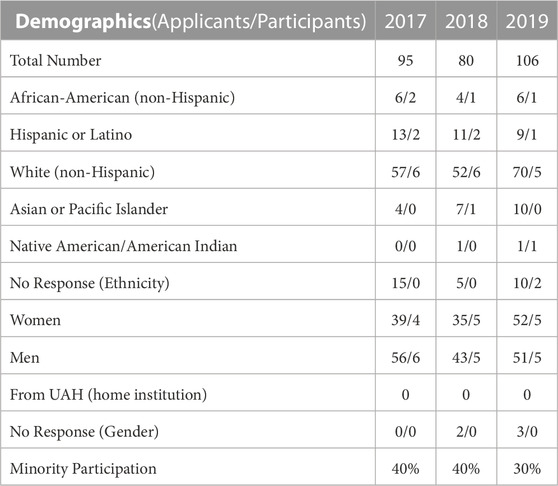
TABLE 1. Breakdown of applicants and participants over the 3 years 2017–2019. Note the gender balance in the past 2 years, and that in 2019 there were more women than men applicants. In each category, the first number indicates the number of applicants in that category separated by “/” from the second number which indicates the number of participants in the same category.
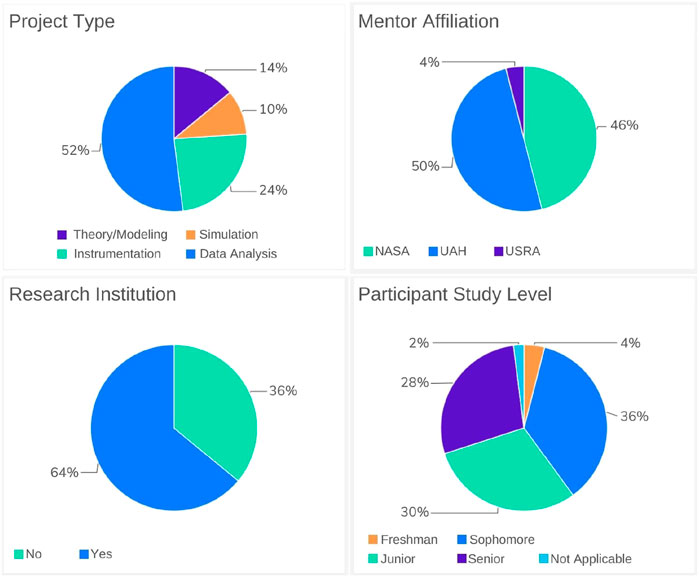
FIGURE 2. Cumulative pie charts for the NSF REU program during the 2016–2019 period showing a breakdown of the project type (top left), the mentor affiliation (top right), the fraction of students from colleges with a PhD program in Physics (yes/no) (bottom left), and the participant study level (bottom right).
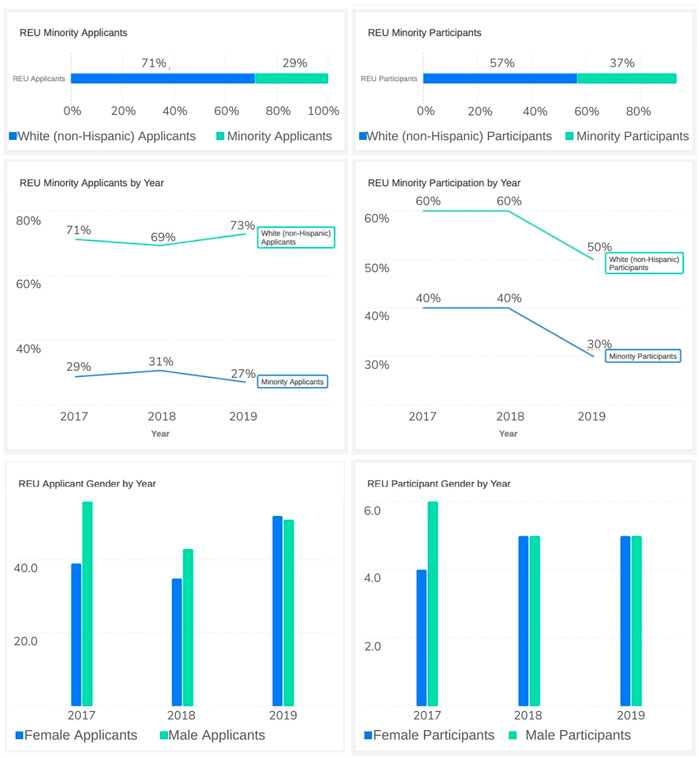
FIGURE 3. Left (top two panels): The REU program recruited women and minorities, obtaining the following breakdown: 29% minority applicants, 46% female applicants. Right (top two panels): Almost half of REU participants were women and over a third were minority, with the following breakdown: 37% minority participation and 47% female participation. Left (bottom): Female REU applicants increased by 33% between 2017 and 2019 with a breakdown of 54% male, 46% female. Right (bottom): REU participant gender is nearly equal with 53% male and 47% female. All averages are over a 3 year period (2017–2019).
In conclusion, we note that we follow up with our REU program alumni after the program in an endeavor to maintain long term relationships, using Facebook and “annual follow-up” emails. This reminds the students of their time with us, and the connection that they maintain with the program and their mentors. Mentors (and the REU Program Coordinator that oversees the entire program) frequently provide reference letters for former students applying to graduate school. Several past participants have indicated that a strong letter from an eminent scientist who speaks highly of their research capabilities has contributed to their acceptance into prestigious schools. Mentors sometimes continue to work with students after the REU program, especially when a student’s work is suitable for publication. Altogether, ten of our REU students were coauthors on ten refereed journal publications over the past 10 years. The publication of a research paper in an international journal makes an enormous impact on a student and we regard this as one of our most satisfying accomplishments with the REU program.
2.2 ALPIP program
2.2.1 Organization
ALPIP has been offered since the summer of 2019 and is a 10-week summer internship program for undergraduate students (in particular, rising juniors and seniors in STEM fields). Recruitment of students was initially focused on students attending Alabama institutions and since been expanded to encompass the NSF EPSCoR southeastern states (Alabama, Arkansas, Kentucky, Louisiana, Mississippi, South Carolina, West Virginia, the United States Virgin Islands, and Puerto Rico). The program was supported by an NSF EPSCoR RII Track-1 grant entitled CPU2AL: Connecting the Plasma Universe to Plasma Technology in AL: The Science and Technology of Low-Temperature Plasma and now by the FTPP program.
2.2.2 Programmatic goals
The goal of the program is to promote plasma physics as a discipline, which obviously includes space physics and plasma astrophysics. Another goal is to recruit students in the southeastern United States into plasma physics-related programs in Alabama, to increase diversity in plasma-related programs, and to bring plasma physics into the AL HBCU research programs. Since many of the students that attend the ALPIP program have little or no knowledge of plasma physics, CPU2AL provides a mandatory on-line plasma physics introduction developed by plasma physics graduate students and post docs that includes some simple quizzes. Thereafter, the ALPIP students attend an in-person intensive one-week summer program given by Princeton Plasma Physics Laboratory (PPPL) as part of the Department of Energy (DOE) Summer Undergraduate Laboratory Internship (SULI) program. ALPIP students participate in lectures, laboratory experiments, and short classes in plasma science. Although not especially technical, the required on-line plasma physics introduction that the ALPIP students take prior to the PPPL courses provides a good overview of plasma physics. This is important because most of the ALPIP students have had little or no exposure to plasma physics, electricity and magnetism, or statistical physics.
After attending the introductory plasma physics program at PPPL, our ALPIP students return to one of the Alabama CPU2AL partner universities for 9 weeks to work on a research project with one or more mentors. The students choose a project prior to the camp from a selection provided by the CPU2AL universities. The projects range from computational and theoretical to data analysis in space and laboratory plasma, while others address the application of plasma to the life sciences. The projects culminate in an in-house poster session and thereafter all the ALPIP students attend the Annual CPU2AL meeting where they exhibit their posters and awards are provided for the best posters. Several projects have resulted in journal publications with their mentors.
2.2.3 Outcomes
Illustrated in Figure 4 is a table illustrating the demographic breakdown from 2019–2022 with a COVID pandemic break during 2020 and a virtual camp during 2021. ALPIP 2022 was the resumption of the in-person program although, notably and importantly, with the PPPL component being offered only virtually. Both the completely virtual 2021 and the 2022 virtual PPPL component had a notable impact on our application numbers which were well below the 2019 numbers. We caution the reader that the complications of the pandemic make it difficult to draw reliable conclusions from the numbers in Figure 4 but some trends are apparent. In 2019, ALPIP support 4 African-American students, 1 Hispanic or Latino student, and 1 Asian or Pacific Islander student, and 6 white (non-hispanic) students for a total of 12 participating students or corresponding to the demographic percentages presented in Section 1, 33%, 8.5%, 8.5%, and 50%, respectively. Of the 12, they were split equally between men and women. The virtual ALPIP camp of 2021 after the canceled 2020 camp had a 60% decline in applications. Despite this, the number of minorities participating was 6 of 13 (2 African-American, 1 Hispanic or Latino student, 2 Asian or Pacific Islander, and 1 Native American student or 15%, 8%, 15%, and 8%, respectively). The split between women and men was the same, 6 and 7 respectively. As illustrated, the demographic breakdown achieved here well exceeds the baseline targets scribed in Section 1. The semi-virtual 2022 ALPIP camp saw a marked decline in the number of minority and women applications. It is unclear as to what the decline can be ascribed. One possibility is that the COVID pandemic affected the return of minority and women students to campuses more than white male students. However, we are unaware of detailed college post-COVID return demographic statistics so this is speculative.
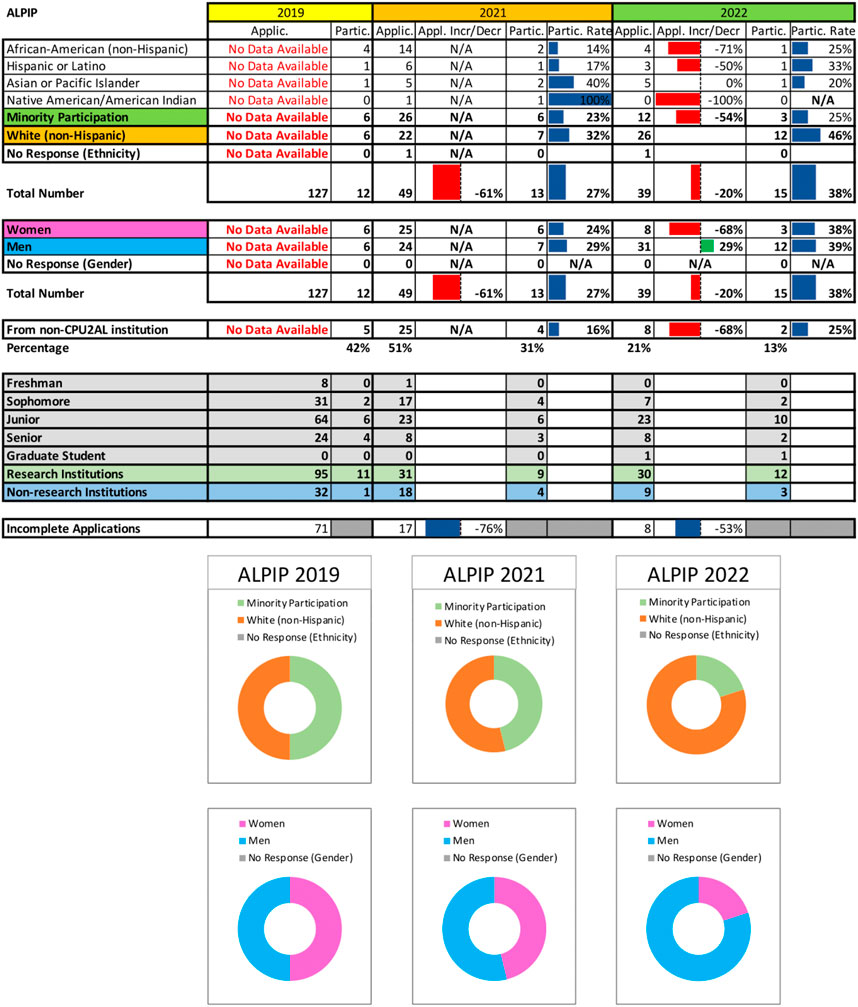
FIGURE 4. Top: Table listing the demographic information, the number of participants, and the number of accepted participants for the ALPIP program for the 3 years 2019, 2021 and 2022. The program was suspended during 2020 because of the COVID lockdown, 2021 was fully virtual, and 2022 was hybrid (part virtual, part in-person). Note that the participant rate is different from the number of participants, being calculated from the ratio of participants to applications. Bottom: Graphical representation of the diversity information (top row is the minority participant and the bottom row the gender participant breakdown) for each of the 3 years.
Despite the complications of understanding the demographic data during the COVID pandemic years, a problem less acute for our NSF REU program, Figure 4 illustrates the potential for significant recruitment and engagement of minority and women students in the broader field of plasma physics. This program is continuing with new NSF support via an entirely new program “Future Technologies and Enabling Plasma Processes” (FTPP). The engagement of ALPIP students at both the PPPL and the individual AL universities participating in CPU2AL and now FTPP allows the students to become part of a larger, national plasma science student cohort, learn about opportunities in plasma science, and be exposed to the research environment of a national laboratory for plasma physics.
2.3 ALREU program
2.3.1 Organization
The State of Alabama has currently three NSF REU programs that are related to space and plasma physics. One is the UAH program discussed above. Both ASU and UAB host NSF REU programs (ASU NSF REU Site “Research & Training in Multidisciplinary Field of Regenerative Sciences for Undergraduates”, and UAB NSF REU Site “Regional Initiative to Promote Undergraduate Participation in Experimental and Computational Materials Research”, respectively) that are led by Principal Investigators that are part of the CPU2AL and now FTPP NSF EPSCoR grant. As we noted above in Section 2.1, students face increasing competition and challenges to be accepted into REU programs around the nation, particularly when they apply from non-research intensive universities and cannot demonstrate undergraduate research experience. This is especially true of many HBCU students. Accordingly, as part of the CPU2AL and now the FTPP program, we piggyback off our three successful and existing independent Alabama-wide NSF REU programs by setting aside CPU2AL funds to support the attendance of three HBCU students at an REU camp of their choosing. With FTPP, this effort has expanded to include students enrolled at HBCU institutions across the southeastern United States (Alabama, Arkansas, Kentucky, Louisiana, Mississippi, South Carolina, West Virginia, the United States Virgin Islands, and Puerto Rico). Not only does CPU2AL/FTPP provide the funding for the students but our CPU2AL/FTPP recruitment team advertises the program, the AL REU or ALREU program, across a broad spectrum of HBCU institutions.
2.3.2 Programmatic goals
Offered since summer of 2019, the ALREU program is a 10-week summer internship program for undergraduate students (in particular, rising juniors and seniors in STEM fields) by leveraging off our existing NSF REU programs in AL. The program provides students with quality research experiences at CPU2AL/FTPP partner institutions in a broad spectrum of PSE/Space Physics disciplines. The ultimate goal of the program is to engage a diverse, educated, and skilled pool of scientists and engineers to promote long-term relationships between students and investigators to enhance the Alabama plasma-related workforce. As more FTPP partners capture NSF REU programs, we anticipate expanding the ALREU program to include more students.
2.3.3 Outcomes
As with the preceding figure, Figure 5 shows a table illustrating the demographic breakdown from 2019–2022 with a COVID pandemic break during 2020 and a virtual camp during 2021. ALREU 2022 resumed the in-person program. Despite the completely virtual 2021 camp, the number of ALREU 2022 applicants roughly mirrored the 2021 numbers. Again, we caution the reader that the complications of the pandemic make it difficult to draw reliable conclusions from the numbers in Figure 5 but some trends are apparent. In 2019, ALREU supported 4 African-American students, split equally between men and women. The virtual ALPIP camp of 2021 after the canceled 2020 camp had a 37% decline in applications and we supported 3 African-American students, all of whom were women. The 2022 ALREU camp saw a modest decline in the number of minority and male applications. It is unclear as to what the decline can be ascribed or if it statistically meaningful.
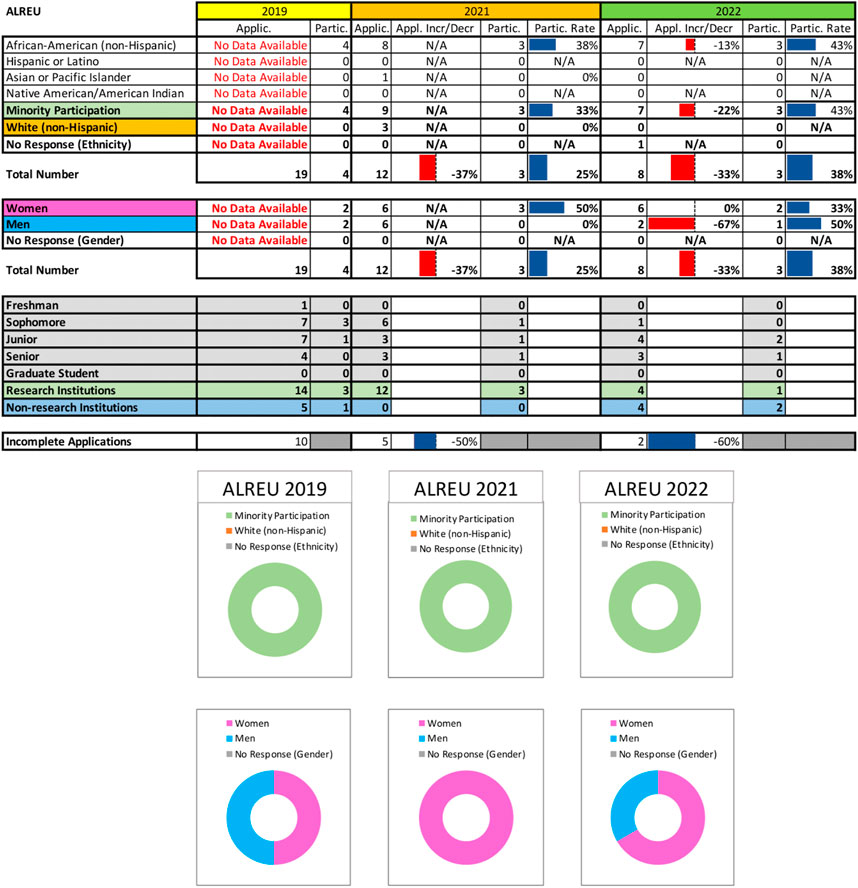
FIGURE 5. Demographic data presented in the same format as Figure 4 for ALREU for the same 3 years 2019, 2021, and 2022.
Despite the complications of understanding the demographic data during the COVID pandemic years, Figure 5 illustrates the potential for significant recruitment and engagement of minority and women students in the broader field of plasma physics. Evidently, ALREU has been successful in leveraging existing supported NSF REU programs in AL to increase exposure of minority undergraduate students to PSE/space physics who would otherwise never have had access to learn about or engage in research on PSE-related topics. As described already, this program is continuing with new NSF support via the FTPP program. The engagement of HBCU students from the southeastern states introduces them to opportunities in plasma science that most of whom have been unaware.
2.4 CIPPTA program
2.4.1 Organization
One of the important Workforce Development-related components of the NSF EPSCoR-supported CPU2AL program was the building of industrial and commercial links to the AL Statewide plasma academic program. An approach that we developed was a 10-week, typically summer, program in which CPU2AL (and now FTPP) sponsors a Corporate Internship Program on Plasma Technology Applications (CIPPTA) (https://www.uah.edu/cpu2al/career-opportunities/cippta) for students pursuing degrees in STEM fields. The program provides students at CPU2AL partner institutions with quality experiences on applying plasma technology at private AL companies. This is an internship in which a STEM undergraduate or graduate student chooses from a variety of projects provided by different AL companies. These projects range from the plasma processing and coating of carbon composites to plasma-liquid interactions and the use of neural networks in plasma applications, thereby providing hands-on experience to the selected students.
2.4.2 Programmatic goals
The goals of CIPPTA are twofold. One is to provide students the opportunity to establish connections with PSE-related industry and university professionals. It is open to undergraduate and graduate students in a broad spectrum of STEM disciplines. The program focus is to engage a diverse, educated, and skilled pool of scientists and engineers to promote long-term relationships between students, academia, and industry to enhance the Alabama workforce. In so doing, we hope to improve the industry-academia connection in plasma physics, which, at least for AL, is not well established. This is the second important goal of the program. While focused more generally on plasma physics applications, the internship program is a clear pipeline into the strong AL (and certainly the Huntsville and Mobile) space and aerospace industrial and commercial sector. Under FTPP, we anticipate expanding CIPPTA further.
2.4.3 Outcomes
CIPPTA is a program that was quite heavily oversubscribed in the pre-COVID years. This is illustrated in Figure 6 in which CIPPTA had 44 applications and we were able to provide only 7 internships. During this year, we were markedly successful in our minority participation with 2 African-American and 2 Asian or Pacific Islander participants out of a total of 7 internships, of which only one was a woman student. The 2021 post-COVID year was partially hybrid and yielded a dramatically smaller number of applications. This led to only 5 internships being awarded, and a slight decrease in overall diversity but a modest increase in woman interns. As with the other programs, the URM and female participation breakdowns are consistent with the targets presented in Section 1. The 2022 year was also significantly impacted although the number of applicants increased from the year before but only three internships were available as the companies struggled to adapt from the COVID pandemic and lockdown.
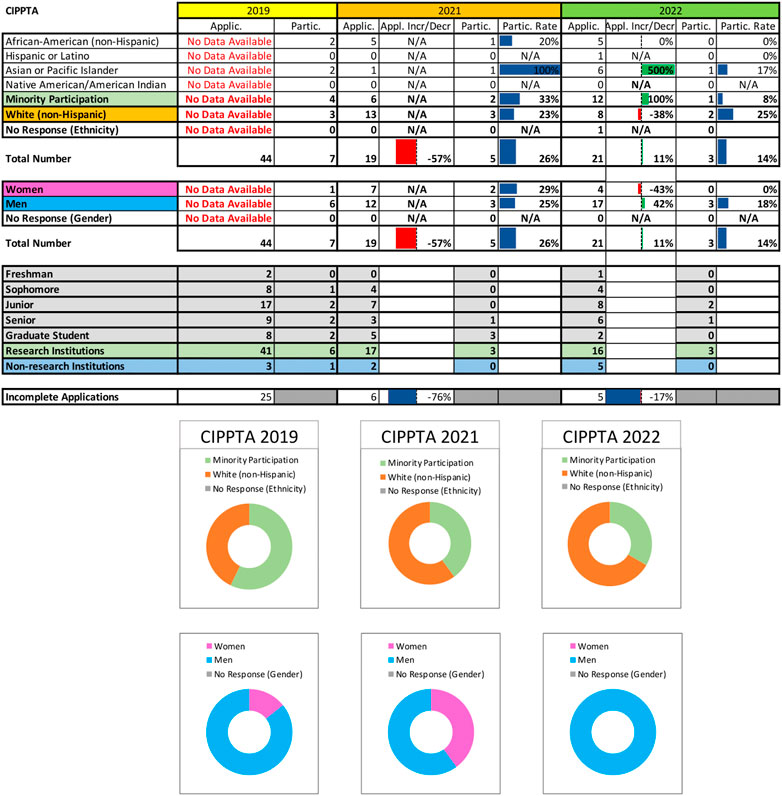
FIGURE 6. Demographic data presented in the same format as Figure 4 for CIPPTA for the same 3 years 2019, 2021, and 2022.
The post-COVID data is difficult to understand, both because of the impact on the students themselves and also because of the impact on the companies providing the internship projects. If the prior-COVID data can be regarded as reasonably reliable, our recruitment of minority students into a hands-on industry-academic internship plasma program was effective in drawing a large number of applications that well reflected the diversity of the State.
2.5 ISWC program
2.5.1 Organization
The International Space Weather Camp or ISWC provides AL students an opportunity to learn about space physics in the context of meeting a very practical need–to understand the influence of the Sun on the space and upper atmosphere of the Earth and to explore its related impact on the technological systems and needs of modern society. This of course is the new, exciting, and emerging discipline of Space Weather. Its societal importance can be judged from the attention paid it by the White House and senior leaders in government, i.e., a recognition of the importance of ensuring that our technology investments are properly protected against severe Space Weather.
The ISWC is now supported in part by the NSF EPSCoR CPU2AL/FTPP consortium as well as the UAH through the Vice President of Research’s Office and CSPAR. The current manifestation of the ISWC derives from the Camp that was run annually since about 2011. Initially, the ISWC resulted from a partnership between UAH and the DLR and the University of Rostock as part of a Memorandum of Understanding (MOU) between the three institutions in 2010/2011. The MOU was a reflection of the considerable historical ties that exist between Huntsville and the state of Mecklenburg Vorpommern (Germany) in the development of rockets, missiles, and eventually manned space flight. The primary initiators of the ISWC were the Director of CSPAR, Gary Zank, and the former Vice President of Research, John Horack, working together with their colleagues at the DLR in Neustrelitz, Wolfgang Mett, Holger Wandsleb, and the University of Rostock’s Wolfgang Schareck (Rektor of the University of Rostock).
After the first 4 years of the ISWC, the program was expanded to include a South African component. The South African National Space Agency SANSA asked to join the program, at which point the program was expanded to create a three-legged program in which 2 weeks of the camp would be spent at two of the three participating institutions on an annual rotating basis. Thus, in 1 year all the students would spend 2 weeks in Huntsville followed by 2 weeks in Neustrelitz, and the following year it might be Huntsville and Hermanus in South Africa, etc. To avoid the complications of funding international partners, each of the partners covers the costs for all the students at their home institution and each partner is responsible for their own travel costs.
The ISWC was further expanded when CPU2AL (and now FTPP) took over the program by incorporating all the AL universities in the CPU2AL/FTPP consortium. The program is now no longer restricted to UAH students but instead incorporates all of Alabama and from this year, the US Southeast region. The purpose behind this expansion was to diversify the ISWC further and to provide opportunities to communities not traditionally engaged in space physics activities.
2.5.2 Programmatic goals
Prior to the pandemic, approximately 10 students from each of the three partners participated, i.e., about thirty students from Alabama, Germany, and South Africa participated in a multiple week series of lectures, hands-on projects and experiments and excursions. The goals of the project are threefold: the first and second are to learn both the theoretical underpinnings and practical applications of Space Weather and solar and space physics. Space weather is assuming an ever larger role in space physics, motivating the need to understand the academic component of space physics better as well as its economic impact on a technological society. The third goal is less tangible but perhaps as important, which is that ISWC was created to forge ties and develop communication between two regions that have had an enormous impact on the 20th century.
2.5.3 Outcomes
Figure 7 provides 11 years of demographic information from 2011–2022. The data from 2011–2020 is not as detailed as the records kept for 2021–22, but the basic demographic information was recorded. The table provides a detailed breakdown, when available, of ethnicity, gender, and educational levels, and whether from a research or non-research institution. The panels below the table of Figure 7 are a simple graphical representation of the yearly breakdown of minority (orange—blue annuli) and gender (blue—pink annuli) ISWC participants. This extended period ensures that the perspective is not skewed excessively by the pandemic period. The columns corresponding to the COVID period also contain the application numbers broken down demographically.
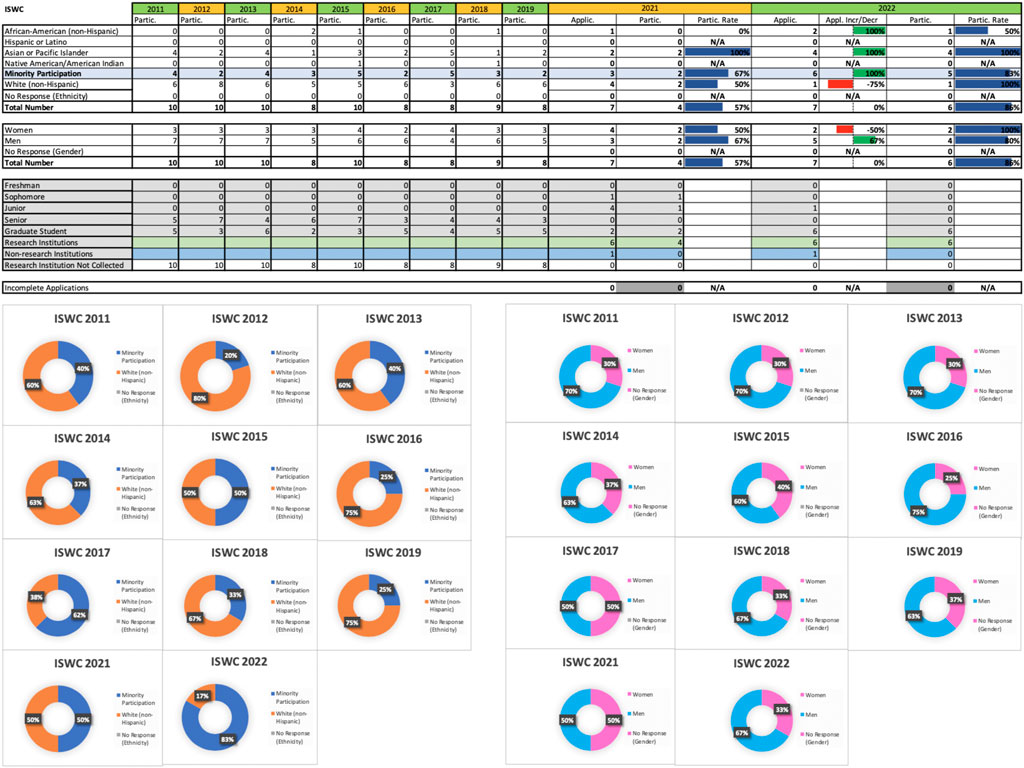
FIGURE 7. Demographic data presented in the same format as Figure 4 for the ISWC for the period 2011–2022. Data collection prior to 2020 was not as detailed as it is currently but basic demographic and gender was collected.
In only four of the years did we have African-American participation but detailed application records were retained only in the last 2 years. A factor that we believe influences these numbers is that the ISWC became more focused on new graduate students after about 2014/15 as we recognized that undergraduates needed exceptional levels of preparation to manage the camp. An additional reason for the graduate student focus is that the German and South African cohorts were exclusively comprised of graduate students and undergraduate students clearly struggled with the program in these countries. Because of the focus on graduate students, this has made recruitment of African-American students into the ISWC exceptionally challenging. Nonetheless, we have been modestly successful and the 2022 African-American ISWC participant switched universities to enroll in a graduate space physics program rather than the graduate physics program he was enrolled in. In terms of diversity measured by the Asian or Pacific Islander category, the ISWC has been very successful in attracting significant levels of participation, well illustrated by the blue-colored annuli of Figure 7, which, despite yearly variability, has a large fraction colored in blue. After the first 3 years, the pink-colored annuli of Figure 7 show good progress in increasing the representation of women attending the ISWC, and despite the downturn in gender diversity in 2022 (which we attribute to the virtual camp), we anticipate rapidly returning to a roughly balanced gender distribution in 2023. We can conclude that the ISWC URM and female participation meets our target goals presented in Section 1.
3 Individual success stories
As much as statistics can tell the story of the success or otherwise of the summer programs and internships discussed above, much greater resonance is frequently achieved through concrete stories and perceptions from individual students. Here, we attempt to summarize the numerous qualitative statements from past interns that illustrate their success in the programs, the role played by our summer programs in students’ subsequent career choices, and the impact on students who are not traditionally or typically exposed to an intensive research environment. In Supplementary Appendix S1, we provide a deeper presentation of the feedback we received from our students, together with some commentary about the broader implications of the student statements for our summer programs, for STEM in general, and for the Alabama and US workforce.
3.1 NSF REU program
Our NSF REU program has been organized uninterrupted since summer 2012 with the exception of 2020 when it had to be canceled due to the COVID pandemic. We therefore have a significant pool of REU alumni gathered over the past 10 years. We perform longitudinal tracking to follow the career paths and current jobs of our alumni. The institutional and sometimes demographic diversity of our REU cohorts is frequently reflected in the chosen career paths. Some chose to pursue graduate education in STEM fields, followed by careers in academia or industry; some went directly to industry after completing an undergraduate degree, and some chose a career path unrelated to the undergraduate majors they were pursuing at the time they participated in our REU program. Regardless of the career paths chosen, the responses to our surveys demonstrated that our REU program affected the career decisions of many of our past REU students. This was also reflected in email exchanges between REU students and their mentors as well as members of the REU Management Team. Although not at all quantitative, it is nonetheless extremely illuminating to present a few individual ‘success’ stories from our NSF REU program alumni who are currently at different stages of their careers.
Besides having recruitment criteria that aim to increase diversity in race, gender, year of study, and attendance in a non-research institution, we have an additional recruitment criterion that encourages admission on a “need” basis. In scoring an applicant’s need, we consider whether the applicant has had research opportunities before and/or attends a research university (i.e., a university that offers a graduate program in the field of study of the applicant). We generally judge an applicant’s need by a combination of their essay, including their interest in our program, letters of recommendation and transcripts indicating their academic preparation, and their knowledge about the program. An application is assigned a point value for each of these categories. In this way, an applicant who is extremely interested and well-prepared, and has previously completed an REU is on equal footing with an applicant who is also extremely interested, but has no research experience and hence has a high “need”. Occasionally, we have applied this “need” criterion to applicants who are extremely interested in our program and attending research universities but are not well prepared academically for various reasons indicated in their applications. We assess such students as having potential that is not easily demonstrated, and this makes it difficult for them to be accepted to any research program given the highly-competitive nature of REU programs today. We have had two such students, one from summer 2012 and another from summer 2019, whom we accepted based on the ‘need’ criterion.
The first student was a rising-senior from a well-known research university in Florida majoring in Astronomy/Astrophysics. He wrote an exceptional essay explaining his interest in our REU program and had good letters of recommendation. However, his GPA was not competitive nor did he have any prior research experience. Both of these factors almost certainly prevented his being accepted into an REU program elsewhere. However, his “need” score was high, which allowed us to accept him into our REU program, where he worked with one of our NASA MSFC mentors. His performance in our program was exceptional and led to his pursuing a graduate degree in Optical Science and Engineering at UAH, from which he was hired by NASA MSFC as an Optical Physicist.
Another anecdotal example of a student with high “need” was a 2019 applicant who was a rising-senior at a well-known research university in California majoring in Astrophysics. She was part of an underrepresented community in STEM fields with a relatively low GPA. However, her letters of recommendation were excellent. Despite having some research experience at her university, she had a difficulty obtaining student research positions elsewhere. Her potential as measured by our need criteria was high and so she was admitted to our REU program. She proved to be an outstanding young researcher and gave an excellent final presentation. Thanks to the positive impact of our program, her senior academic year proved very successful. After graduation, she was determined to pursue a graduate education in Physics and applied for a number of programs in research universities of different rankings in the US but was unsuccessful. Consequently, she began to work in industry but her priority remained to enter graduate school. She applied for a second time to various schools and was recently admitted to the graduate program in Physics at a well-known research university in Georgia. For both her application attempts, we provided her with very strong letters of recommendation.
Our 2021 cohort included a female applicant who was a rising-junior attending a non-research university in South Carolina majoring in Mathematics. She had neither prior knowledge of Solar and Heliospheric Physics nor any research experience. She had also made a decision about pursuing graduate studies. She completed our REU program, finding it a life-changing experience. She is currently in her senior year and planning to apply for graduate programs, especially in the area of Astrophysics.
Finally, we point out an interesting outcome from the REU Poster Competition that we have organized since summer 2021. The top three poster presenters receive various prizes (including a first prize winner having the opportunity to attend an international conference outside the US). In 2021, the second place student came from a Californian community college. In summer 2022, the first and third place winners came from a non-research university in Iowa and a community college in North Carolina, respectively. None of these students had any prior knowledge of Solar and Heliospheric Physics! Besides reflecting good mentorship with our program, it illustrates very clearly that the opportunity to engage in cutting-edge space physics research projects, appropriately tailored, is highly engaging and stimulating to all of our students, even those with relatively little experience or who are “not-so-strong on paper.” Given the opportunity, our REU students have uniformly been very eager to learn about Space Physics and their enthusiasm supports and encourages everyone in the cohort.
3.2 ALPIP program
We request feedback from our students at the end of their ALPIP internship using an exit program survey. Of the various questions asked in the survey, two provide particular insight into the success of our program: “Overall, how would you rate your internship experience?” and “Did your mentor have a positive effect on your experience?“. The breakdown of responses to the first question was, with respect to the year of the program, as follows: 2019—58% “Excellent”, 25% “Good”, and 17% “Fair” from a cohort of 12 students; 2021 was a virtual program—54% “Excellent”, 38% “Good”, and 8% “Poor” from a cohort of 13 students; 2022—67% “Excellent”, 27% “Good”, and 6% ‘Fair’ from a cohort of 15 students. The breakdown of responses to the second question was: 2019—92% “Yes”, and 8% “No”; 2021—92% “Yes”, and 8% “No”; 2022—93% “Yes”, and 7% “No”.
The student feedback also includes comments about their internship experience. Some examples are “After this internship, I’m more than confident in my career goals now! I hope to enter into a materials science Ph.D. program to study plasma!”; “It was great. I was really scared at first and felt welcomed and comfortable very quickly. It felt like everyone really wanted to make sure we all had the best experience that we could. I learned a ton. I would definitely do it again if I was given the chance.”; “I enjoyed the experience a lot. I felt the experience helped me get a clearer idea of what I wanted to pursue in my career. This experience I think has been an important step in professional development.”
What is brought out by these comments is the evident impact on 1) encouraging and developing career and professional goals; 2) instilling confidence that career and academic aspirations can be realized, and 3) drawing strength, inspiration, and confidence from their peers and mentors. These factors are strong drivers for students electing to continue their studies in STEM and as a result, develop the technical skills for the future Alabama and national workforce.
3.3 ALREU program
As above, we ask the same two questions of our ALREU students, obtaining the following responses to the first question: 2019—75% “Excellent”, and 25% “Good” from a cohort of 4 students; 2021 was a virtual program—67% “Excellent”, and 33% “Good” from a cohort of 3 students; 2022—100% “Excellent” from 3 of 4 students. For the second question, our ALREU students answered “Yes”.
Some of the ALREU student feedback about the internship experience is as follows: “It was a great internship! It was really nice to learn about plasma and it is future in agriculture. There was so much challenge as the chemistry of the plasma activate water was complex. But I learned that researches can be difficult at a times and the more you read the more information you will get and also you might not get all the experience but I learned to react to challenges and learn from mistakes and working with teams and asking for advice and reach to a goal. Overall, it was really eye opening project and I will take my experience to graduate school and continue my research journey.”; “I enjoyed this internship experience and will definitely suggest to fellow undergraduates”; “I gained new skill set and knowledge base which would not have been possible without my mentor’s approach to mentorship”.
The impact of the ALREU program mirrors the statements above.
3.4 CIPPTA program
As discussed, the CIPPTA program is unlike the more traditional summer programs that we run in that it is a bridge between academia and industry. This program is motivated strongly by the CPU2AL and FTPP goal of developing the Alabama workforce. Like our other internships, it has been very successful and until the pandemic, the program was enormously oversubscribed. Response to the first question asked above were: 2019—43% “Excellent”, and 57% “Good” from a cohort of 7 students; 2021 was a virtual program—80% “Excellent”, and 20% “Good” from a cohort of 5 students; 2022—33% “Excellent”, 33% “Good”, and 33% “Poor” from a cohort of 3 students. For the second question, 93% of our entire CIPPTA cohorts replied “Yes”, and only 7% replied “No”.
Comments from our CIPPTA interns about their internship experience include: “This internship was a great opportunity to experience the industrial working environment and fill the gap between academic research and industrial R&D” “As a computer engineering student, I believe that working on problems related to plasma physics is a great way to apply knowledge in technology and computer engineering. I was fortunate to have the opportunity this summer to apply a lot of things I’ve learned”.
These are just a few of the many “success” stories we have experienced with our students. Witnessing the achievements and enthusiasm of the students is highly motivating to our mentors, who because of this, are willing to spend time, summer after summer, working with a highly diverse group of students.
4 Conclusion
The field of Space Physics is certainly of significant interest to society, but it also offers a unique opportunity to draw young people into STEM education fields. Space science, whether exploring the Sun, interplanetary space, Solar System planets and bodies, exoplanets, stars and interstellar space, has the capacity to excite the imagination and interest of almost everyone regardless of age, gender, or demographic group. We have been looking into the skies for the entire history of humanity drawing inspiration, knowledge, cultural mores, and wonder that translates into a compelling interest in space science generally. Entering STEM via space science is a key to open the breadth of STEM to our children and students. The summer programs that we offer at the state, national, and international levels give a diverse population of undergraduate and graduate students the opportunity to learn about Space Physics and engage in cutting-edge hands-on projects. With the increasing number of success stories about recruitment in the field every year, our summer programs are a good example of how to address the question of increasing diversity in the field of space physics and thence STEM in general. As described above, we have attempted to provide a reasonable quantification of the successes of our summer programs, and we summarize the current status here with a set of summary charts.
Figure 8 provides a useful summary of the four CPU2AL (and now FTPP) programs in terms of applications, participants, diversity, and gender. Focusing only on the 3 years 2019, 2021, and 2022 (the 2020 programs being suspended), our programs had 352 applicants and we were able to support 75 participants across all four “workforce development” programs. As discussed above at some length, and clearly illustrated in the top right plot of Figure 8, the number of applicants dropped significantly after the COVID-19 pandemic. Even by 2022, the application numbers had not improved. The average acceptance rate was 21% and it rose from 12% in 2019 to 36% in 2021 because of the much smaller number of applications. The summer programs recruited women and minorities obtaining overall numbers of 33% minority applicants and 38% female applicants, averaged over a 2 year period (2021–2022 since no data was available for 2019). This translated into 39% of the participants being women and over half, 52%, were minority students, averaged over a 3 year period (2019–2022).
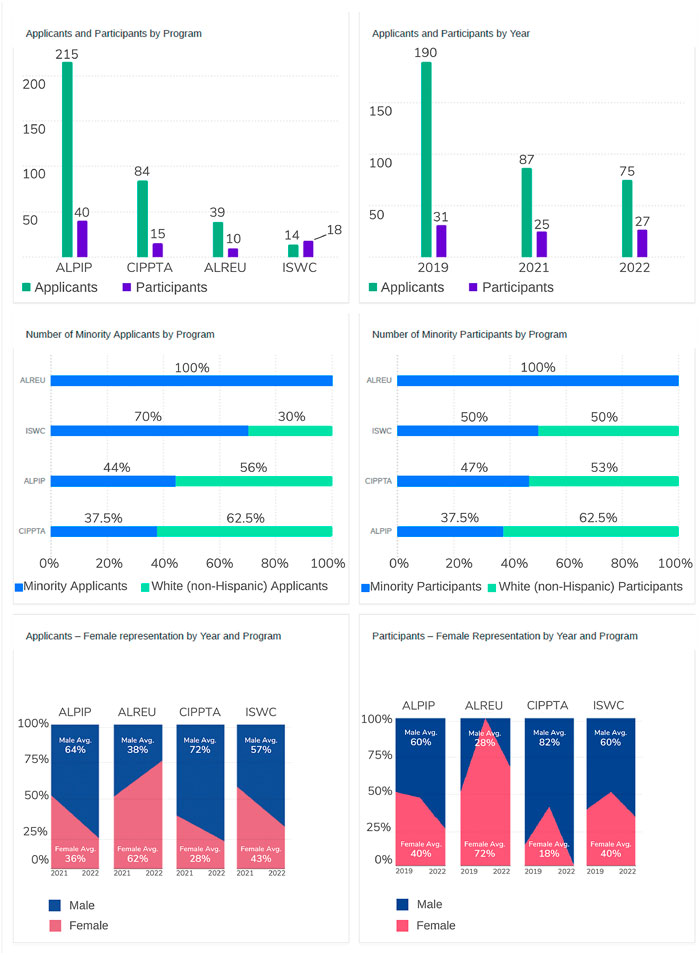
FIGURE 8. Summary of demographic data for the four CPU2AL summer programs over 3 years 2019, 2021, and 2022. No summer programs were held in 2020. Top left: Total number of applicants and participants per program for the three-year period. Top right: Total number of applicants and participants per year. Middle left: Total number of minority applicants by program. Middle right: Total number of minority participants by program. Bottom left: Total number of female applicants by year and program. Bottom right: Total number of female participants by year and program.
Figure 9 is a cumulative summary of the CPU2AL ALPIP program. Almost half of ALPIP applications are minority students, i.e., 44% on average over a 2 year period (2021–2022). This translated into 38% minority participation but there was a 30% decrease in minority participants on average over a 3 year period (2019–2022). The COVID pandemic appeared to have a larger impact on our minority students than our white (non-Hispanic) participants. A similar decrease was seen for female applicants and participants as we were slowly emerging from the pandemic, with 30% of applicants from 2021 to 2022 being female. The number of female applicants decreased by 68% between 2021–2022. The average female participation numbers reflected the application numbers with 37% female participation from 2019–2022, and similarly female participation decreased by 50% between 2021 and 2022.
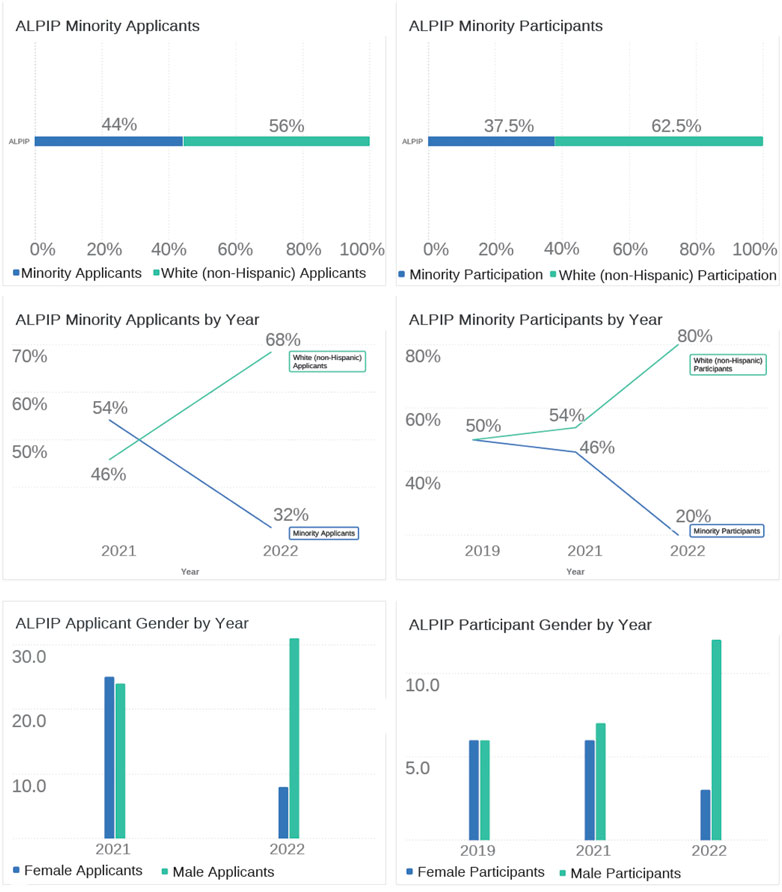
FIGURE 9. Summary of demographic data for the CPU2AL ALPIP summer program over 3 years 2019, 2021, and 2022. Top left: Total number of applicants. Top right: Total number of minority participants. Middle left: Total number of minority applicants by year. Middle right: Total number of minority participants by year. Bottom left: Total number of female applicants by year. Bottom right: Total number of female participants by year.
A summary of the ALREU program is given in Figure 10. The ALREU program leverages the NSF REU programs that operate currently throughout the State of Alabama with CPU2AL recruiting exclusively minority students, especially from the HBCUs in AL. Therefore, all applicants and participants are minorities. However, over half of ALREU applicants are female, with 60% female applicants average over a 2 year period (2021–2022). The bottom right panel shows that the ALREU program increased or maintained female participation with 63% female participants on average over a 3 year period (2019–2022).
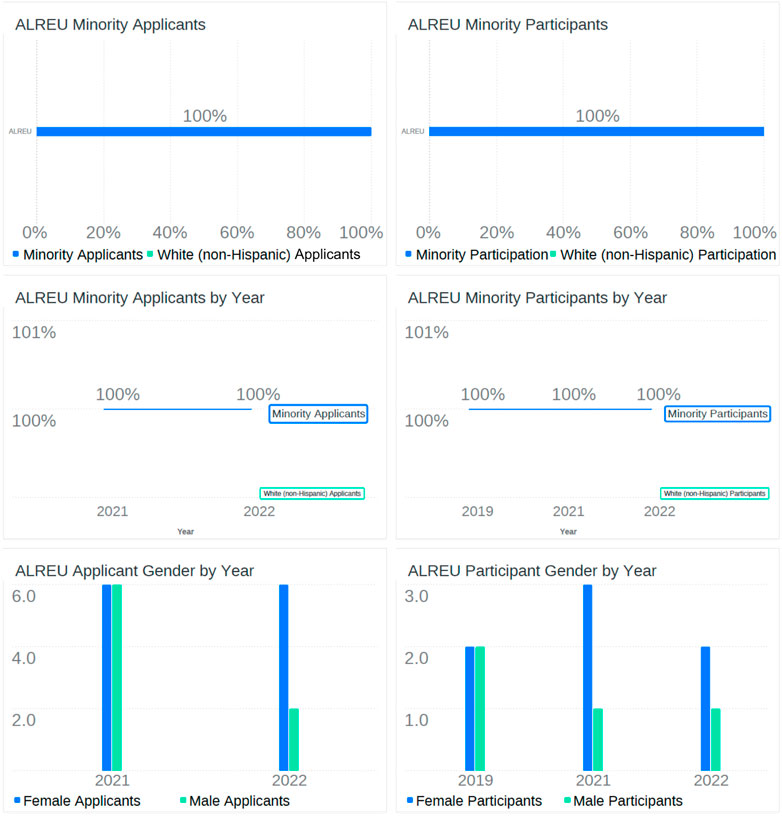
FIGURE 10. Summary of demographic data for the CPU2AL ALREU summer program over 3 years 2019, 2021, and 2022 in the same format as Figure 9.
The cumulative demographics of the CIPPTA program are shown in Figure 11. Over one-third of CIPPTA applicants were minorities (38%) on average over the 3 year period. Overall, nearly half (47%) of CIPPTA participants were minorities although the number of minority CIPPTA participants decreased by 24% over 3 years, possibly reflecting again the outsize impact of the pandemic on minority communities. Of concern is the bottom panel of Figure 11 which shows that 19% of the CIPPTA applicants in 2022 were female. CIPPTA has the lowest number of female applicants of all our summer programs despite having a reasonable number of minority applicants. As a consequence, the CIPPTA program has had fewer female participants than male participants each year, with none in 2022.
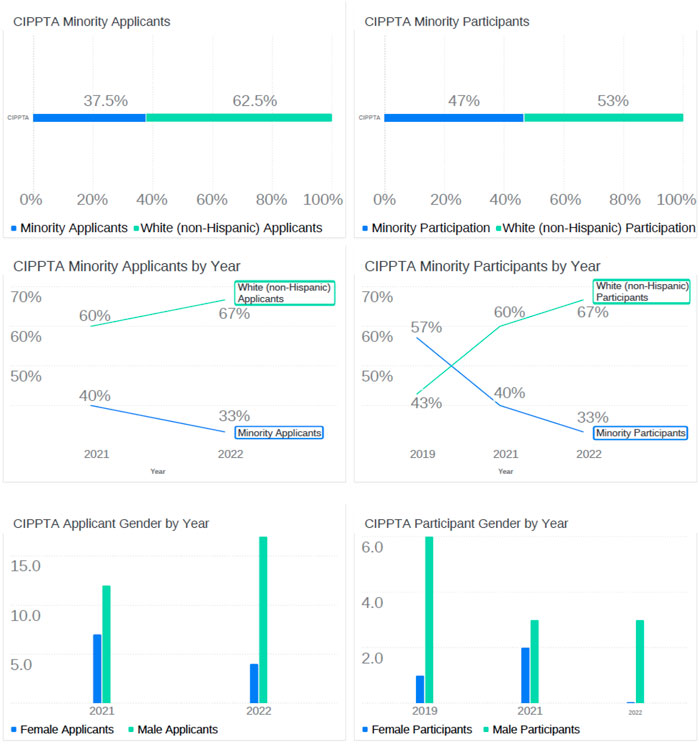
FIGURE 11. Summary of demographic data for the CPU2AL CIPPTA summer program over 3 years 2019, 2021, and 2022 in the same format as Figure 9.
We conclude with a summary of the last 2 years (2021–22) of the CPU2AL-supported ISWC in Figure 12 since we have complete data for these 2 years. Over this period, the ISWC had 70% minority applicants and participants, specifically 70% average minority applicants and participants (2021–2022) and 83% minority applicants and participants in 2022. Some 43% of the ISWC applicants were female and they made up 40% of the participants during this period. We draw attention again to the data presented in Section 1 on which we based our target numbers for URM and women participants. Figure 8 shows the cumulative breakdown of the diversity distribution of the PSE-affiliated summer program students. In view of the PSE statistics quoted in Section 1, as measured by both applications and participation, the summer program DEI numbers far exceed the participation levels of women and underrepresented groups for physics as a whole and PSE in particular. The URM and female breakdowns also exceed our nominal targets that were based on growing our student numbers by
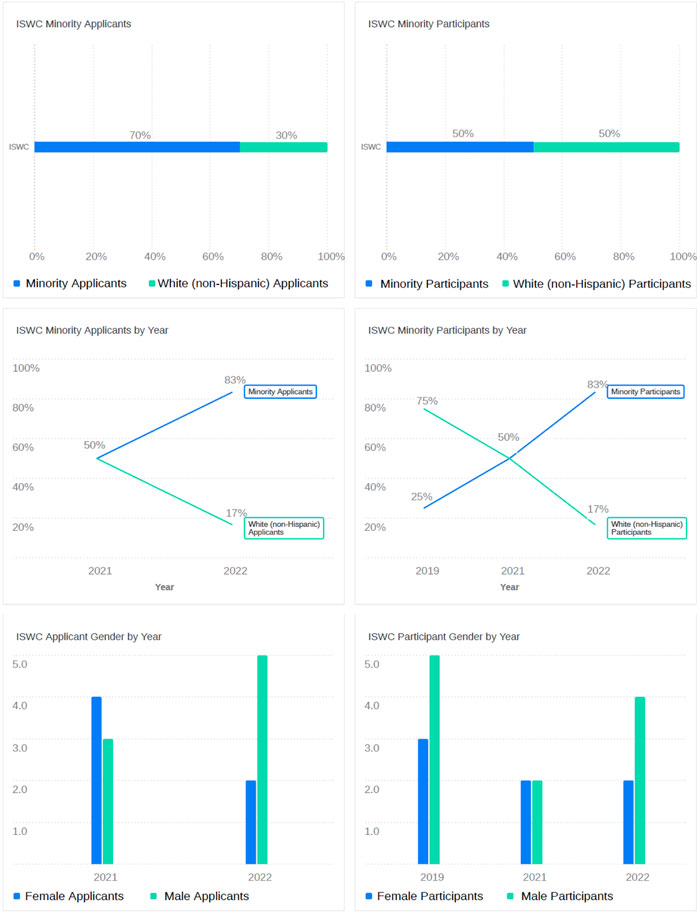
FIGURE 12. Summary of demographic data for the CPU2AL ISWC summer program: Applicant and participant data over the 2 years 2021, and 2022 for which we have complete data. We also present participant data for 2019. The format is the same as Figure 9.
The success of our students, often best gathered anecdotally rather than in dry statistical charts, in our various summer programs motivates many of us to provide a high-quality research experience to students from diverse backgrounds. Not only is this of immense value to the students themselves with many either continuing their STEM education path as undergraduates or other continuing on to graduate studies in STEM fields but also it contributes to a vital state and national need in creating a highly-qualified US workforce.
Author contributions
MY is the Program Coordinator of the REU Program and the Co-Investigator of the REU grant. He contributed to the writing of the paper. GZ is the Principal Investigator of the NSF EPSCoR projects CPU2AL and FTPP, and the REU grant and contributed to the writing of the paper. LP is the Education, Outreach and Diversity Coordinator of CPU2AL and FTPP. She created the figures, compiled the success stories for the EPSCoR internship programs, and contributed to the writing. DS and KH contributed to the analysis of the data from the EPSCoR internship programs. All authors contributed to the article and approved the submitted version.
Funding
We acknowledge support from the NSF EPSCoR RII-Track-1 Cooperative Agreements OIA-1655280 and OIA-2148653 for the ALREU, ALPIP, CIPPTA, and ISWC programs. The REU program is funded by the National Science Foundation under award number AGS-1950831. Any opinions, findings, and conclusions or recommendations expressed in this material are those of the author(s) and do not necessarily reflect the views of the National Science Foundation.
Conflict of interest
Authors DS and KH were employed by the company Edu Inc.
The remaining authors declare that the research was conducted in the absence of any commercial or financial relationships that could be construed as a potential conflict of interest.
Publisher’s note
All claims expressed in this article are solely those of the authors and do not necessarily represent those of their affiliated organizations, or those of the publisher, the editors and the reviewers. Any product that may be evaluated in this article, or claim that may be made by its manufacturer, is not guaranteed or endorsed by the publisher.
Supplementary material
The Supplementary Material for this article can be found online at:https://www.frontiersin.org/articles/10.3389/fspas.2023.1155972/full#supplementary-material
Abbreviations
ALPIP, Alabama Plasma Internship Program; ALREU, Alabama Research Experiences for Undergraduates; ASU, Alabama State University; CIPPTA, Corporate Internship Program on Plasma Technology Applications; CPU2AL, Connecting the Plasma Universe to Plasma Technology in AL; CSPAR, Center for Space Plasma and Aeronomic Research; DEI, Diversity, Equity, and Inclusion; DLR, German Aerospace Center; FTPP, Future Technologies and Enabling Plasma Processes; HBCU, Historically Black Colleges and Universities; ISWC, International Space Weather Camp; MSFC, Marshall Space Flight Center; PPPL, Princeton Plasma Physics Laboratory; REU, Research Experience for Undergraduates; SANSA, South African National Space Agency; SPA, Department of Space Science; SULI, Summer Undergraduate Laboratory Internship; UAB, The University of Alabama at Birmingham; UAH, The University of Alabama in Huntsville.
Footnotes
1https://www.agu.org/-/media/Files/Learn-About-AGU/AGU_DEI_Dashboard_2020_baseline_demographic_snapshot.pdf
2https://spaceskills.org/public/docs/SSA%20Demographics%20of%20the%20UK%20Space%20Sector%202021.pdf
3https://www.aps.org/programs/minorities/bridge/bridge-inst.cfm
4https://www.agu.org/bridge-program
7https://www.nsf.gov/statistics/states/interactive/show.cfm?stateID=53,1&year=0
8https://www.uah.edu/cspar/research/reu
9https://www.uah.edu/cpu2al/career-opportunities/alpip
10https://www.uah.edu/cpu2al/career-opportunities/alreu
11https://www.uah.edu/cpu2al/career-opportunities/cippta
12https://www.uah.edu/cspar/iswc
References
Mulvey, P. J., Nicholson, S., and Pold, J. (2021). Trends in physics PhDs: Results from the 2019 survey of enrollments and degrees and the degree recipient follow-up survey for the classes of 2017 and 2018. Tech rep Also available at: https://www.aip.org/statistics/reports/trends-physics-phds-171819.
National Academies of Sciences- Engineering-Medicine (2021). Plasma science: Enabling technology, sustainability, security, and exploration. Washington, DC: Tech report. doi:10.17226/25802
Keywords: space physics, diversity, summer programs, ALPIP, ALREU, CIPPTA, ISWC, REU
Citation: Yalim MS, Zank GP, Provenzani L, Spencer D and Howatson K (2023) Diversity in the space physics community: an overview of collaborative efforts led by The University of Alabama in Huntsville. Front. Astron. Space Sci. 10:1155972. doi: 10.3389/fspas.2023.1155972
Received: 01 February 2023; Accepted: 15 May 2023;
Published: 06 June 2023.
Edited by:
Michael W. Liemohn, University of Michigan, United StatesReviewed by:
Xochitl Blanco-Cano, National Autonomous University of Mexico, MexicoAdam Kellerman, University of California, Los Angeles, United States
Copyright © 2023 Yalim, Zank, Provenzani, Spencer and Howatson. This is an open-access article distributed under the terms of the Creative Commons Attribution License (CC BY). The use, distribution or reproduction in other forums is permitted, provided the original author(s) and the copyright owner(s) are credited and that the original publication in this journal is cited, in accordance with accepted academic practice. No use, distribution or reproduction is permitted which does not comply with these terms.
*Correspondence: Mehmet S. Yalim, bXN5MDAwMkB1YWguZWR1
 Mehmet S. Yalim
Mehmet S. Yalim Gary P. Zank1,2
Gary P. Zank1,2 Laura Provenzani
Laura Provenzani